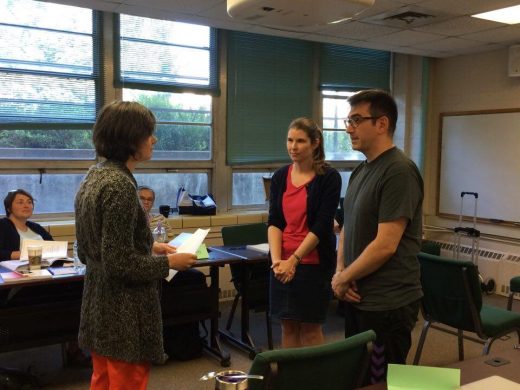
Are you interested in finding new ways to use your Modern Languages degree? Consider medical interpreting! Medical interpreters work in health-care settings to “facilitate understanding in communication between people who are speaking different languages” (A Textbook for Medical Interpreters, CCHP 2014). Between August 8-12, 2016, 11 Kansas State University students, faculty, and staff completed the “Bridging the Gap” medical interpreting training.
This is a forty-hour training course for beginning and intermediate medical/social service bilingual interpreters. Participants in the course learned to apply the Interpreter’s Code of Ethics, to demonstrate the appropriate roles of an interpreter, to demonstrate the modes of interpreting, to demonstrate cultural competency practices, and to identify medical terms. The course was presented by Jewish Vocational Service (JVS) and taught by Raul O. Guerrero.
How is interpreting different from translation? A translator is a knowledgeable, detail-oriented reader who re-writes a text for a new target audience with a different language and culture. An interpreter applies cultural, linguistic, and content-area expertise to convey spoken messages between speakers of different languages. Dr. Laura Kanost (Associate Professor of Spanish)
What are some of the most interesting or useful things you learned from this workshop?
- “It was really interesting to see some of my professors and work with them in a professional environment where we could all practice skills together.” Seth Dills (Undergraduate Elementary Education major)
- “I found the role-plays followed by the discussion very effective to really cement the theory and practice of medical interpreting.” Angelique Courbou (Modern Languages Department Coordinator)
- “It was interesting to see how learning a foreign language can be useful. This training was specifically for medical interpreting, but it gave me ideas about how to introduce students to where they can be headed with language skills.” Kumiko Nakamura (Instructor of Japanese)
- “What I enjoyed the most was acting as interpreter during the role plays. It was great to put into practice the theory we learned, but at the same, it was difficult. Speaking two languages doesn’t necessarily make a person a good interpreter between those languages, and I was immediately reminded of that when acting as interpreter.” Dr. Earl Brown (Associate Professor of Spanish)
To learn more about Bridging the Gap: http://www.jvskc.org/language-and-cultural-services/